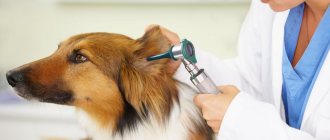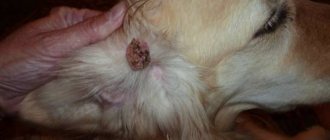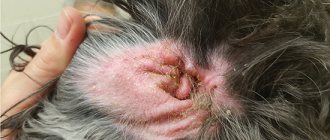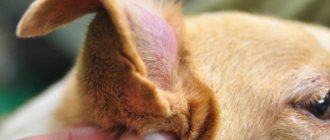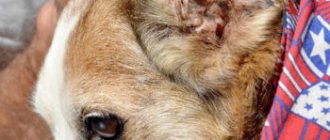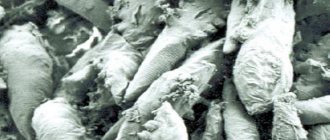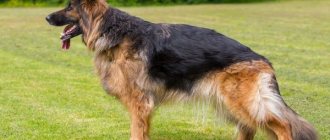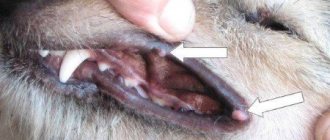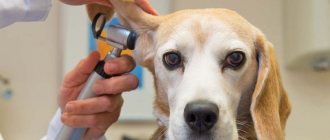What kind is this?
This type of otitis is characterized by damage to the hearing organs by pathogenic fungi. They penetrate from the outer ear into the middle and inner ear, causing tissue damage.
What is the difference?
The main difference between fungal otitis and other types of disease is that it develops secondary, against the background of another disease that was not treated or was treated incorrectly. Most often, such otitis is provoked by infections, allergies and reduced immunity.
How to help your pet: Medicines
The key to successful treatment and the absence of relapses is eliminating the root cause.
Often, treatment for dermatophytosis may not be necessary, as spontaneous regression of the disease may occur. However, the therapy is still worth using, as the risk of spreading spores and infection, including to people, is reduced.
Treatment includes topical medications: Liverazole, Lime Sulfur, Shampoos with ketoconazole . It is also necessary to use systemic drugs, for example Terbinafine .
To destroy spores in the environment, use a 1% solution of bleach , smoke bombs based on enilconazole, for example Klinafarm .
To enlarge the picture, click on it
Causes
The causes of this disease are:
- Weakened immunity. This is especially true if the animal is often exposed to stress or walks in the cold.
- Inflammatory process. It provokes the development of fungal otitis, creating a favorable environment for its development.
- Damage to the skin in the ears. Leads to the appearance of wounds and the development of fungus in them.
- Long-term use of antibiotics. It can lead to disruption of the immune system, and this leads to the proliferation of the fungus.
- Allergic reaction. Weakens the body, creates an optimal atmosphere for the development of fungus.
The fungus appears if the dog’s health has deteriorated due to another disease. Harmful microorganisms choose for reproduction an organism with a weakened immune system and an inflammatory process.
Fungus on dogs' paws: Treatment
Often, especially in the autumn-winter period, fungus occurs on the paws of dogs. Treatment includes local treatments. In case of extensive lesions or difficult local therapy, systemic treatment is prescribed. We must also not forget about eliminating the root cause that causes fungus on the dog’s paws.
Topically, you can use 2-4% chlorhexedine, for example, Chlorexiderm spray . You can wash your paws after a walk with Malacetic . Cheap and affordable means you can use a 2-3% solution of ordinary table vinegar .
It should be noted that to monitor treatment, cytology must be re-taken periodically, since the reddish-brown color of the coat and claws may persist. It will be eliminated only when the skin derivatives are completely renewed.
To enlarge the picture, click on it
Forecast and consequences
Doctors give a positive prognosis for the treatment of this disease. When taking medications, fungal otitis media can be overcome. Your pet's ears can be completely cured by eliminating the pathogens.
But at the same time, medications are taken not only for otitis media, but also to increase immunity and eliminate infection in the body. It is important to defeat the primary disease so that fungal pathology does not arise again.
If you do not treat your dog, the consequences of the disease will be:
- partial or complete hearing loss;
- elevated temperature;
- strabismus;
- purulent discharge from the eyes;
- The area inside the ear is swollen.
Symptoms
The following symptoms help determine the presence of pathology:
- bloody streaks in the ears;
- pus in the painful area;
- redness of the skin located in the inner part of the ear;
- the dog shakes its head frequently;
- when you touch the ear, the pet whines and tries to wriggle out;
- plaque on the eyeballs, discharge from the eyes;
- discomfort when yawning.
The animal's hearing deteriorates. If previously the owner did not need to repeat commands, then with the disease this has to be done. The pet becomes irritable, weak, and has no energy. He lies down a lot, whines, and touches his ear with his paw.
What does fungus look like in dogs?
Unfortunately, fungal infections look nonspecific. With dermatophytosis, there may be areas of fur on the skin that look like they were cut with scissors, with peeling and sometimes redness.
Itching is usually not observed unless there is a secondary infection. Less common is kerion, a nodular skin lesion caused by mycosis.
Yeast-like fungi of the genus Malassezia can color the fur and claws a reddish-brown color. There may be a coating on the skin of the same or yellowish color. Redness is also often present.
A waxy brown discharge may be found in the external auditory canals. Cutaneous candidiasis is extremely rare and may be characterized by ulcerations.
Treatment
Drops
Treatment is carried out using medication. Anti-inflammatory drops are prescribed:
- Otipax;
- Sofradex;
- Tsiprovet;
- Aurizon;
- Otoferonol;
- Otinum.
Antibacterial drops Anandin, Fugentin, Nitrofungin, and Clotrimazole solution are also effective. If the disease has developed significantly, the antibiotic Amoxicillin is used. It is introduced into the body by injection, or the dog is given tablets.
Other drugs
Additionally, drugs are prescribed to enhance immunity: Roncoleukin, Gamavit, Cycloferon, Immunofan.
The dosage and duration of drug use are calculated individually by the veterinarian. It takes into account the age, weight of the dog, the rate of development of the disease, its stage. It is dangerous to calculate the dosage yourself - you can harm your pet.
Breed predisposition
All dogs, regardless of breed, can suffer from this disease. Fungal otitis occurs due to infections, decreased immunity, improper or insufficient ear care.
But despite this, experts identify a risk zone in which East European Shepherds . Their ear canal is too wide, into which dirt can easily get in; it can quickly become hypothermic while walking in the winter. This can cause an inflammatory process and the spread of fungus.
Fungus in a dog's ears: Treatment
When treating otitis media, it is also important to eliminate the root cause. The most common fungus in dogs' ears is Malassezia. For successful recovery, it is necessary to clean the external auditory canal.
So what you need to do:
- Lotion ( Epiotic, Otifri, GlobalVet, Rosinka) or regular saline solution NaCl 0.9% . The latter is best used if it is not known whether there is a perforation of the eardrum.
- The ears are gently massaged at the base.
- Let the dog shake its head as much as possible.
- Gently remove visible discharge with cotton pads. Important! You cannot clean your ears with cotton swabs, as this will only cause the exudate to clog deeper.
- You don’t need to rinse your ears every day, as this can only further injure the inflamed tissues. Usually in a day or two.
15 minutes after washing, medications are injected into the external auditory canal. Use only local products. Systemic antibiotics are the only treatment required for otitis media.
If the external auditory canal is so narrow due to inflammation that drops cannot be administered, then a short course of corticosteroid tablets is used, for example Prednisolone .
The choice of drops in the ears depends on the cause of otitis media, the condition of the eardrum, whether there is bacterial or fungal overgrowth, or parasites.
Surolan can be classified as a “for everything” drug . The drugs included in the composition relieve inflammation, have antimicrobial and antifungal activity, and also help against otodectosis.
Even for fungal otitis, complex remedies are used: Posatex, Isotik, Oritsin, Otidez .
In some cases, the dermatologist himself makes “talker” - homemade drops that have the composition necessary for a particular case.
In dogs with a large amount of hair in the ears, it is recommended to trim them after the inflammation is relieved.
Note that the course of treatment for fungal otitis is long, in most cases from three weeks. Every 4-7 days, the effectiveness of treatment is monitored - otoscopy and cytological examination of the contents of the external auditory canal.
To enlarge the picture, click on it
In pregnant women, lactating women and puppies
Dogs during pregnancy, nursing, and puppies can suffer from this type of otitis.
Symptoms of the disease and diagnosis are usually no different. But the treatment is indeed being adjusted: antibiotics and various injections are prohibited, since they can harm the animal during this period. Anti-inflammatory and antibacterial agents are suitable for treatment.
These dogs need more attention and care. They are weakened and refuse to go for walks. The owner must be patient, provide balanced nutrition, drinking, and comfortable conditions for treatment.
It is recommended to provide your pet with a warm corner where he can lie down and gain strength. You need to approach him more often, show care, and if there are signs of deterioration, immediately call the veterinarian.
As a preventive measure, regular ear care, examination, balanced nutrition, and timely treatment of infections are suitable. To prevent the dog from catching a cold during a walk, dress it warmly. Pregnant, lactating dogs and puppies are more likely to catch colds due to reduced immunity.
Fungus in dogs: Diagnosis
For any lesions of the skin and ears, it is better to first consult a veterinary dermatologist.
As a rule, the initial appointment takes at least an hour. This is necessary for collecting a complete medical history, examination with otoscopy and taking material for research.
Diagnosis of dermatophytosis:
- Wood's lamp glow.
- Trichoscopy - examination of wool under a microscope.
- PCR.
- Sowing on a nutrient medium.
- Histological examination of the putative kerion.
Yeast-like fungi:
- Cytological examination of a smear-imprint, skin scraping.
- Trichoscopy.
- Sowing on nutrient media.
Read other articles about dogs How to brush your pet: How to brush your dog’s teeth: How to care for your dog’s ears:
Is it transferable?
Transmission from dog to human is unlikely because humans have a higher resistance to the disease. In addition, fungal otitis media is caused by internal processes. But it’s worth knowing the precautions: examine the dog’s ear only with gloves; After contact with an animal, wash your hands well.
The disease rarely spreads from dog to dog. This usually happens if both pets have had an infection, have reduced immunity and often have head or ear contact, but this is unlikely.
Prevention
To prevent the occurrence of this disease, remember the following preventive measures:
- Long-haired dogs are regularly trimmed to improve ear ventilation;
- the diet must be balanced so that the dog receives vitamins;
- the animal’s ears should be dry, moisture is an excellent environment for fungus;
- The pet's ears are cleaned periodically;
- in the cold season, dogs are dressed warmly to prevent colds;
- You cannot wash the ears of healthy dogs with special solutions, as this will disrupt their microflora.
Preventative measures are the best way to prevent this disease. Owners of all dogs should keep these in mind.
